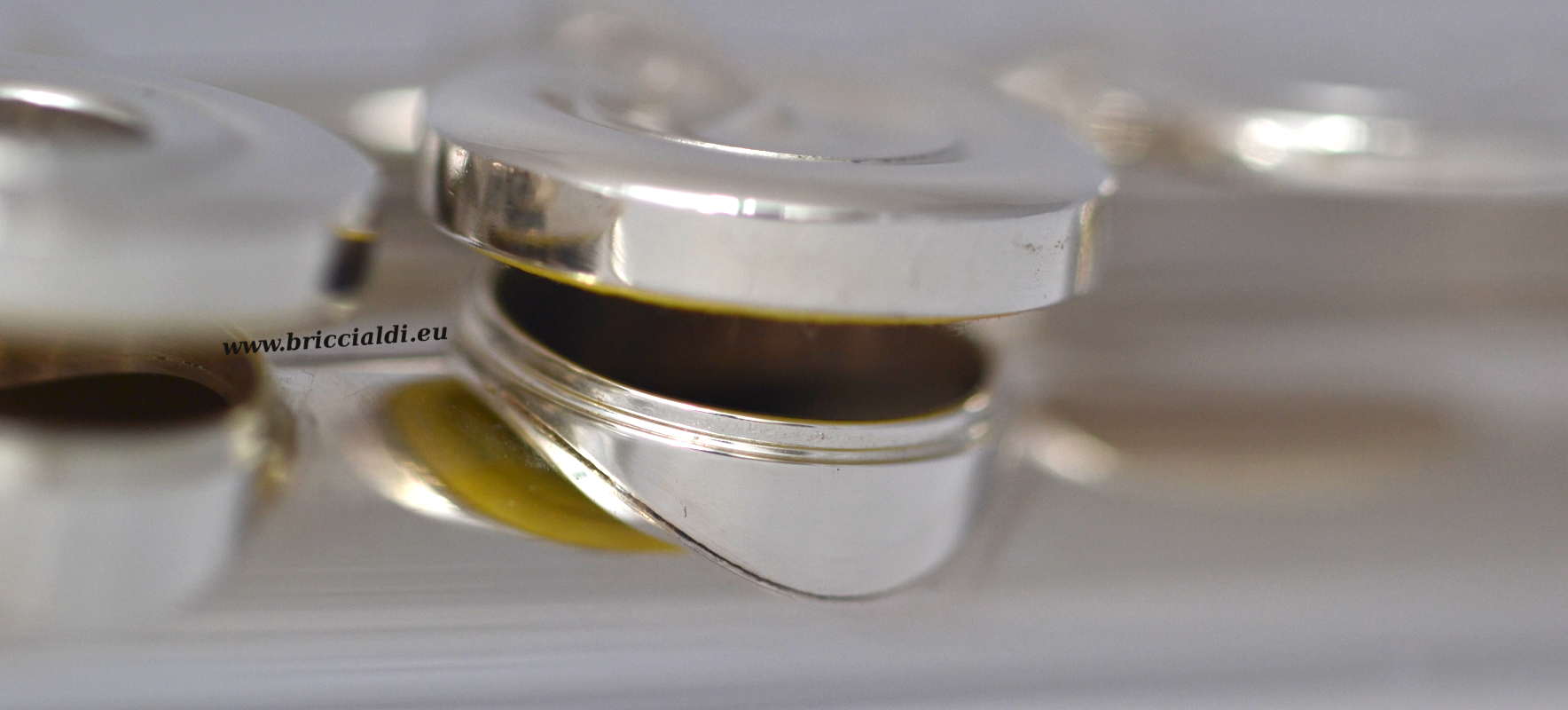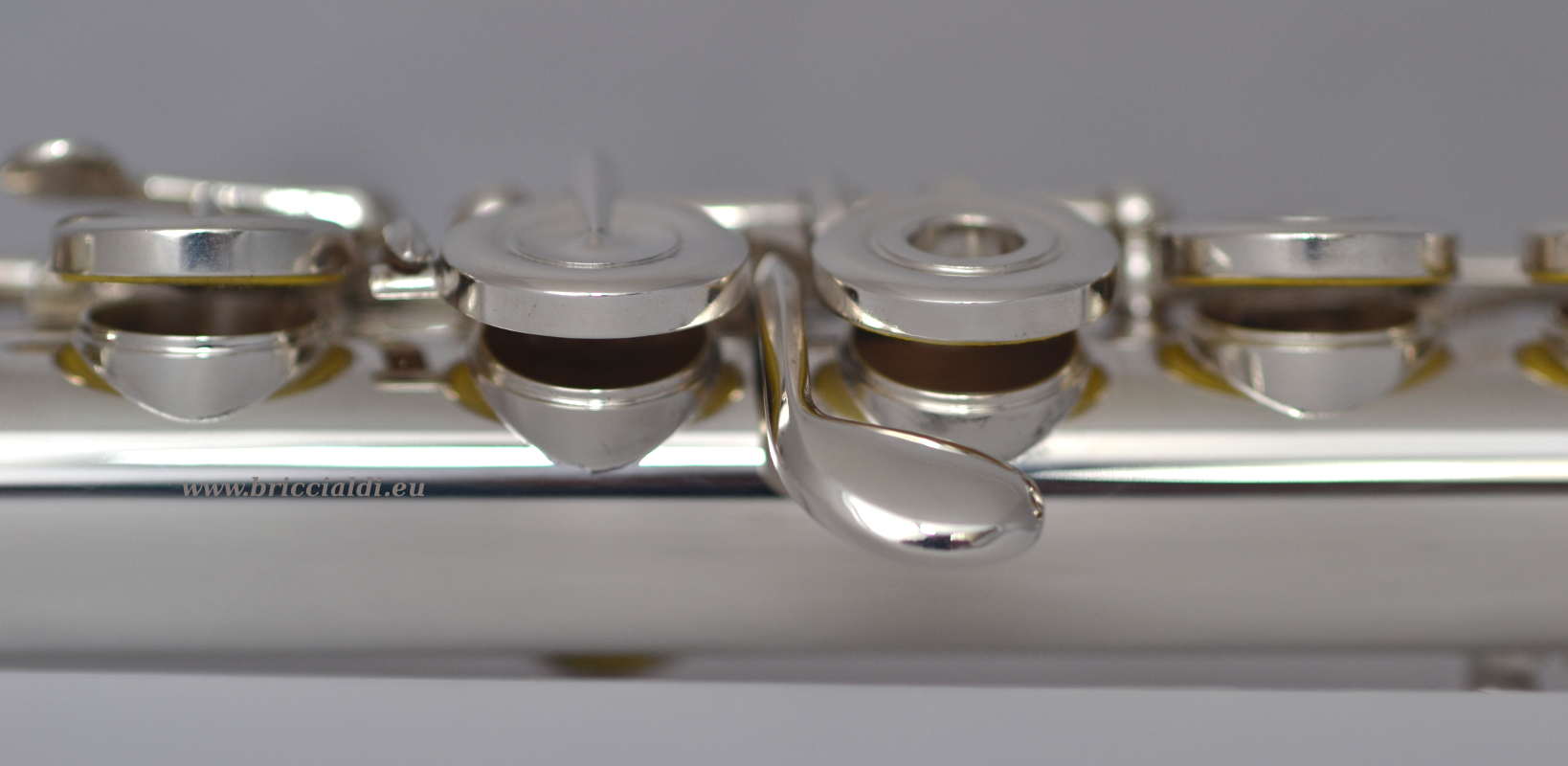Soldered Tone Holes

Caminetti Saldati

Nuovo modello “1818-S”
TESTATA INTERAMENTE IN ARGENTO 925
CAMINETTI SALDATI HANDMADE
TAMPONATURA PROFESSIONALE SINTETICA CON STABILIZZATORE S2
Altamente resistenti all’umidità e con un grado superiore di precisione in fase di chiusura
Materiali
- Testata interamente in argento 925. Suono più pronto, di facile emissione e denso su tutti i registri
- Corpo, Trombino in alpacca argentata
- Doppio Strato di argentatura
- Particolare lavorazione dell’argentatura: costruiamo solo flauti traverso argentati perchè diversamente la finitura nickelata potrebbe dare luogo a comprovati fenomeni allergici, oltre a rendere la superficie del flauto opaca. Eseguiamo un doppio strato di argentatura che conferisce alla superficie del flauto traverso maggior resistenza ai fenomeni ossidativi causati da sudorazione o agenti atmosferici, oltre a rendere il suono più ricco e caldo.
Caminetti lavorati a mano e poi saldati sul tubo
- i caminetti vengono lavorati separatamente e poi vengono saldati in corrispondenza dei fori sul tubo. In questo modo il caminetto ha una parete visibilmente più spessa
- arrotondamento degli spigoli interni (undercutting) e l’esecuzione di alcune svasature che migliorano la risposta acustica del flauto.
- I caminetti saldati sono tipici di una lavorazione artigianale, molto impegnativa e costosa.
- il bordo del caminetto sarà sempre regolare e pianeggiante con indiscutibili vantaggi nell’affidabilità della chiusura ermetica dei tamponi.
- Il caminetto saldato rende il suono del flauto più caldo e corposo (per via del maggiore spessore dei caminetti saldati rispetto a quelli estrusi)
Tappo a vite in titanio opzionale
- Dispositivo che lascia vibrare più liberamente la testata.
- Sostituisce il normale tappo a vite in sughero con un altro costruito a mano in TITANIO il quale rende il suono più chiaro e controllabile ad ogni registro.
- La CORONA ESTERNA in titanio è già installata gratuitamente su tutti i nostri nuovi modelli 203. Mentre è possibile ricevere anche il tappo interno in titanio già installato nel flauto traverso: + 30€
- Per avere un suono più timbrato e denso, consigliamo il tradizionale tappo in sughero (incluso nel prezzo).
Trombino discendente al Do
a richiesta è possibile ordinare anche un trombino discendente al Si
Sol fuori + Mi snodato
- Il Sol fuori linea permette al dito anulare della mano sinistra di raggiungere il tasto Sol con più facilità.
- è una particolare leva che consente di emettere il MI acuto con più facilità.
Chiavi a fori aperti
- E’ un foro al centro del tasto da chiudere direttamente con il polpastrello. In questo modo l’aria che scorre all’interno del flauto traverso è a contatto con le dita.
- È un caratteristica meccanica tipica del flauto traverso professionale. Rende possibile eseguire i glissati spostando il dito sul tasto, in modo da aprirlo gradualmente.
- L’apertura dei fori consente maggiore vibrazione della colonna d’aria all’interno del tubo con conseguente aumento di sonorità.
- I tappini in dotazione servono per poter chiudere il foro e quindi imparare a suonare il flauto traverso a fori aperti gradualmente.
- A richiesta è possibile ordinare flauti a fori chiusi (opzione sconsigliata).
Braccetti alla francese (French pointed arms)
- Visivamente è un braccetto che che arriva fino al centro del tasto
- Ha la funzione di conferire maggiore forza durante la fase di chiusura ed anche più robustezza evitando che il tasto si deformi con il tempo.
- Esteticamente conferisce più eleganza alla meccanica, tipica dei flauti traverso professionali.
Accessori
- Astuccio in similpelle
- Borsa/fodero tracolla
- Panni per la pulizia esterna ed interna con scovolino in legno.
- OPZIONALE: Elegante astuccio in legno sagomato: + 80 Euro
Model “1818-S”
STERLING SILVER HEADJOINT
HANDMADE
Our model “1818” is produced handmade.
This feature emerges not only from tone holes accurately soldered (and not extracted),
also for the great attention to details.
Syntethic S2 padding work with stabilizer.
| Material |
STERLING SILVER HEADJOINT Step1 |
| Soldered Tone Holes |
Since drawn and rolled toneholes are constructed from the flute tube itself, the flute has slightly less metal and weight than a flute with soldered toneholes. A thicker tube will generally provide a darker, richer sound. Many flutists find that they can achieve the flexibility they desire along with the complexity of sound typically associated with soldered toneholes by selecting the optimal tubing thickness. Because soldered toneholes are made separately from the flute tube, they are by nature thicker than drawn and rolled toneholes. This characteristic, combined with the solder or braze that is used to fuse the toneholes to the flute tube, brings more weight to the tube. The result is a flute with positive resistance and a dark, dense sound. Soldered toneholes are generally a good choice for flutists who play with a fast and compact air stream by providing stability without overpowering the flute.The soldered tone holes are perfectly flat so the the pads closing are more reliable over time |
| Footjoint | C-Foot |
| Headjoint | The flute has our Step-1 ready and bright sound STERLING SILVER HEADOINT really appreciated by many flutists. |
| E-Mechanism | A split E mechanism allows venting only one G key while fingering high E. This facilitates production of the high E and it provides a more stable response. |
| Synthetic S2 pads | These pads are made of mostly synthetic materials. The advantage of this is that they do not absorb moisture and as a result do not change shape. This consistency gives the pads a high degree of reliability. Synthetic pads with stabilizer, which are made using a stable plastic base and durable synthetic leather, have been widely adopted as essential components of a high quality Handmade flute. Compared to traditional felt and paper pads that require frequent adjustments, They are more tolerant of environmental change and remain in top playing condition for a longer period of time.Synthetic pads enables the player to achieve a clear response with a more mature, nuanced sound |
| Open Holes
with Plugs |
central openings are covered by the fingertips when depressed. Students may use temporary plugs to cover the holes in the keys until they master the more precise finger placement needed to play open-hole keys. Some players state that open-hole keys permit louder and clearer sound projection in the flute’s lower register.Open holes can be used for effects such as bending and shading, and the player can crack some holes to bring pitch back up when playing softly on high register notes. Playing open holes requires and therefore develops fingering accuracy that is not essential on plateau keys. Some clever trills that make use of the open hole venting for better pitch. Open hole flutes can be used as closed hole by inserting plugs in the holes |
| Offset G | the G keys are offset slightly from the rest of the keys, mounted on their own posts, separate from the other keys. A growing number of flutists prefer the comfort and hand position on the offset G flute. |
| French pointed arms | A key design that connects keys to the rod with a raised, pointed arm which extends to the center of the key. Also refered to as “Styled keys”. It gives more strenght to the keys. |
| Accessories | leatherette case
Bag wooden pipe cleaner. |


